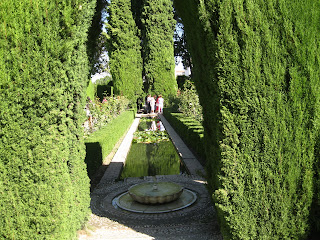Our latest school trip was to Galicia, an area in the Northwest of Spain that boasts deep Celtic ties due to its proximity to Ireland. Also, the climate and the physical features (so we were told) are akin to those in Scandinavia Although, never having been to Scandinavia, I am unable to verify that, I can say that Galicia was the most beautiful and different part of Spain that I have ever seen. There were waving hills that became massive rock cliffs which dropped into the unrepentant and violent Atlantic and beaches of glittering mica.
First we went to the Tower of Hercules, climbed it, and left. Afterwards we drove into Coruna, a city in Galicia, and explored. While there, a couple of us went to the beach and "waded" (got soaked) in the rollicking waves that would both barely touch your toes and submerge you thing deep if you stood in one place for over a minute. That night we stayed in cabins in the country side, and saw traditional Gallegan dancing.
The next day we saw the church of San Andres. Every Gallegan is required to make a pilgrimage here at least once, or else they will be reincarnated as lizards and insects (which is why you are encouraged not to step on lizards and insects in this area).
The next day we saw the church of San Andres. Every Gallegan is required to make a pilgrimage here at least once, or else they will be reincarnated as lizards and insects (which is why you are encouraged not to step on lizards and insects in this area).
At San Andres you can also make a wish by tying a piece of cloth around a tree or a fence, which will come true once a strong wind blows and it falls. None of us had spare pieces of cloth, so we used the baby wipes that I carry on trips (proving once again how eternally useful they are).
Finally, they took us to the top of a hill that flowed into the ocean, a nice change of pace from the usual of just seeing museums, palaces, and cathedrals.
Finally, we went to Santiago de Compostela, a church that is the end of "El Camino de Santiago", a pilgrimage that people from all over the world undertake. It started out hundreds of years ago as a way for people to absolve themselves of their sins, and continues to serve that purpose today, as well as provide adventure. Also, jailed convicts can serve the final throes of their sentence by doing the pilgrimage. We weren't allowed to spend much time in the church, as it was during mass, but they did take us up to the roof!





















